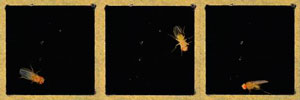
Flies walk on all surfaces but tend to stay near the edges of a chamber, a behavior that is correlated with anxiety.
Reproduced from Ref. 1 and licensed under CC BY 4.0 © 2016 Farhan Mohammed et al.
About 1 in 14 people in the world suffer from an anxiety disorder. Research into the condition is a huge field, but despite the prevalence of the disorders and intense research, there are still no optimal drug treatments available. Now, a group at the A*STAR Institute of Molecular and Cell Biology show that flies can be used to analyze basic anxiety mechanisms.
The image of a rat in a maze is a cliché thanks to the widespread use of these animals in neuropsychiatric research. But, using rats and mice to analyze anxiety mechanisms and discover drugs to treat anxiety has not lately been successful. “The proof is in the pudding: rodent research hasn’t produced an effective new anxiolytic in at least 30 years,” says Adam Claridge-Chang, head of A*STAR’s Laboratory of Translational Neurogenetics.
Vinegar flies, Drosophila melanogaster, are a model system that has dominated the animal genetics field for more than a century. “I wondered if Drosophila could be also used to analyze anxiety,” says Farhan Mohammad, the project’s lead experimental scientist. Using automated video tracking to analyze the flies’ behavior, the group found that the animals naturally stuck close to the walls of a container, exhibiting ‘exposure avoidance’ behavior.
When given diazepam, an anxiety-reducing tranquilizer, the flies were more likely to venture from the walls. Deleting a serotonin transporter increased the wall-hugging behavior, suggesting increased anxiety. Subjecting the flies to environmental stress such as heat, physical restraint and social isolation provoked similar effects. These findings match those from mouse models, verifying that flies have an anxiety-like state that is regulated by similar pathways to humans. The scientists hope their research will complement and guide work in rodents.
Using vinegar flies will improve experimental reliability by allowing researchers to conduct tests more quickly and cheaply and with much larger sample sizes. Also, the genetic tools available to modify Drosophila are far more advanced than for their mouse counterparts. The team was also able to show that a number of vinegar fly genes pertain to fly anxiety, including several genes related to serotonin, a neuromodulator.
“There are no human genes known to be associated with anxiety disorders,” Claridge-Chang notes, “we don’t know very much about the genetic or molecular underpinnings of either anxiety or depression. However, clearly neuromodulators like serotonin have enormous effects on emotional state, so it is a priority to understand how these systems work.”
The team is now using their fly anxiety assay to elucidate basic neurogenetic mechanisms of anxiety.
The A*STAR-affiliated researchers contributing to this research are from the Institute of Molecular and Cell Biology. For more information about the team’s research, please visit the Claridge-Chang lab webpage.



